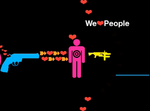Are Advertisements to Blame for the Demise of the Evening News?
Posted in: Uncategorized As the death knell sounds for the evening news, there may be a few culprits to blame who have gone unmentioned. One of them is advertising.
As the death knell sounds for the evening news, there may be a few culprits to blame who have gone unmentioned. One of them is advertising.
This is not because ad rates have dropped for evening news shows or because demographics have skewed to older viewers. Simply put, the ads that run during the evening news are unwatchable.
No fewer than 90% of the commercials that run during the three major network broadcasts are for prescription drugs, with the vast majority targeting an audience over 50 years-old. No one enjoys watching these commercials, so one must change the channel to escape. Inevitably, one switches the channel to another network’s news broadcast in time to view a different prescription-drug ad. Basically, one ends up changing channels three or four times during a break to avoid an ad for one-a-day (insert prescription drug here).
It becomes tedious.
Beyond the notion of why prescription-drugs ads were ever allowed on television, to have these dominate the nightly news broadcasts comes off as giving up on ever reaching younger audiences again. What is really happening here: The evening news is actually pushing younger people away, not to mention some older ones as well, who’d rather not watch these commercials either.
These are the kinds of things just may be killing off the evening news. Competition from cable and the Internet, etc. are part of the story, but they may be just that, part of it.
Garth Meyer is a copywriter and former columnist/newspaper reporter in Oregon. Contact him at: garthmeyer@att.net.
B-52’s, Headlights, or Jugs: Breast Cancer Org’s Target Men
Posted in: Uncategorized This post covers two of my favorite topics: Breasts and advertising. When they’re grouped together, it usually means a 30-minute Girls Gone Wild infomercial. However, this post actually covers a couple advertising efforts behind breast cancer awareness, which is nothing to joke about. While humor is used in writing, and can be seen in the TV spots, no disrespect, implied or otherwise, is intended. My prayers go out to all those who have been affected by breast cancer.
This post covers two of my favorite topics: Breasts and advertising. When they’re grouped together, it usually means a 30-minute Girls Gone Wild infomercial. However, this post actually covers a couple advertising efforts behind breast cancer awareness, which is nothing to joke about. While humor is used in writing, and can be seen in the TV spots, no disrespect, implied or otherwise, is intended. My prayers go out to all those who have been affected by breast cancer.
All men love breasts. Some love them secretly. Others wear t-shirts that shout out that they are “breast men.” Even men that don’t dig women are drawn to a woman’s chest…not sexually, but out of curiosity. (It’s a cruel society that labels a straight man as a stalker for staring at a woman’s assets for too long while a gay man has free reign to reach right out and grab a woman’s chest in public…)
Listaholic alphabetizes 138 different slang names for breasts, among them; whimwhams, muffins, kawangas, and dinglebobbers. Which proves that when men don’t understand something, they either rename it or make fun of it.
The truth of the matter is that we probably love breasts more than their owners;
We just don’t know why…
Which leads to an obvious question: Why haven’t men been involved in the fight against breast cancer from the beginning? Like a favorite bra, it’s a natural fit; breast-lovers attacking breast cancer. As you’ll read in a couple of seconds, a couple of organizations figured it out.
According to the World Health Organization, approximately 500,000 people die every year as a result of breast cancer. It ranks as the second most common form of cancer, and it’s the 5th highest cause of cancer deaths.
The push towards early detection and education of breast cancer began in earnest in 1982, following the death of Susan G. Komen. Susan was diagnosed with breast cancer in 1977 and died three years later. Susan’s younger sister, Nancy, was the impetus behind the push; keeping a promise to her sister, she founded The Susan G. Komen Breast Cancer Foundation with the belief that education, early detection, and research would have saved Susan.
Now known as Susan G. Komen for the Cure, or simply Komen, the foundation has raised over $1.3 billion dollars for cancer research since inception and is the largest cancer charity in the world. On the global level, Komen has but one mission: To end breast cancer forever.
Spurred by National Breast Cancer Awareness Month (October), two separate advertisers have launched PSAs that have expanded their target audience to include men, which is ingenious: Who thinks about breasts more than men?
Yoplait has just released, “Yoplait Pledge.” It makes fun of the fact that nicknames were given to breasts at some point (hmm).
The second awareness spot comes from ReThink Breast Cancer, a Toronto-based organization that addresses the breast cancer concerns of young people affected by the disease. Rethink is a volunteer organization that is “thinking differently” on methods to defeat breast cancer (like getting men involved). The spot (below) is airing in Canada on MTV, and the woman featured is an MTV Host.
It’s obvious that breasts get plenty of attention. It’s breast cancer that we need to focus on.
Jeff Louis: Media Planner, Brand Project Manager, blogger, and aspiring writer. Please leave a comment or follow him on Twitter. As always, thanks for reading.
Crème de la Crap: The Tracy Awards for Worst Advertising
Posted in: Uncategorized Just how many advertising messages are we exposed to on a daily basis? In Data Smog, author David Skenk writes that the average American’s exposure to advertising has grown from “560 daily advertising messages in 1971. By 1997, that number had increased to over 3,000 per day.”
Just how many advertising messages are we exposed to on a daily basis? In Data Smog, author David Skenk writes that the average American’s exposure to advertising has grown from “560 daily advertising messages in 1971. By 1997, that number had increased to over 3,000 per day.”
While the figures are controversial due to the definition of the word “advertising,” even 200 hundred messages a day is more than we’ll remember. Be thankful for that, because most of them are crap that shouldn’t have made it past the concept stage.
While the number of victims stricken by “Crapvertising” is unknown, there is a place where those who have fallen prey can expose the offender(s): The Tracy Awards. Based on the premise that advertisers produce a lot of ”bad ads,” the First Annual Tracy Awards are accepting submissions for the Worst in Advertising 2009. Its call to action:
“There’s a lot of bad advertising out there. Let’s make fun of it.”
Noted as the first competition of its kind, The Tracy’s provide those exposed to terrible advertising an opportunity “strike back” at advertisers who produce crap. The press release goes on to explain:
Every ad we receive will be judged. Harshly. And if it’s bad enough, it will win a Tracy, which will be sent to the people responsible for creating the abomination in the first place. Plus, all ads that win Tracy’s will be nationally publicized as the Worst Advertising of 2009.
 The Tracy Awards were conceived by Salt Lake City ad agency Crowell Advertising and are named for agency founder, Tracy Crowell.
The Tracy Awards were conceived by Salt Lake City ad agency Crowell Advertising and are named for agency founder, Tracy Crowell.
Take a few minutes to view the crap or submit some. If you are like me, making fun of others’ work will make the day so much better.
Jeff Louis: Media Planner, Brand Project Manager, blogger, and aspiring writer. Please leave a comment or follow him on Twitter. As always, thanks for reading.
Advertising and Football: A Perfect Match
Posted in: Uncategorized Football is here, the glorious season of games, players, stadiums, grill-outs, and beer. What many people don’t realize is that it’s also the beginning of the newest advertising campaigns. Yes, we all know that the Superbowl is a haven for new, witty commercials, but what about the rest of the season?
Football is here, the glorious season of games, players, stadiums, grill-outs, and beer. What many people don’t realize is that it’s also the beginning of the newest advertising campaigns. Yes, we all know that the Superbowl is a haven for new, witty commercials, but what about the rest of the season?
You may be surprised to know that many of the greatest commercial campaigns have been started during football games during the typical season, and for advertising companies, this is the perfect time to showcase their top A-game commercials (pun intended).
Football is something everyone watches, and it’s seen as a reason for everyone to get together. This makes it the perfect time not only to target an audience, but to also reach out to even more people that may not usually be interested in your product.
Take, for example, the coming of the Geico caveman. More than likely, this first commercial was aimed at men (hello, caveman?!), but because it was broadcast during football, female viewers also saw this commercial and found it funny. It was witty, unique, and most importantly, it started a conversation.
I know what you’re thinking – Wait, guys don’t watch commercials, they flip through channels on breaks – but hold on, they do watch commercials when they don’t want to miss those first few moments after the break when the game comes back on, especially if a call or penalty will be made. What better time to target that demographic?
Probably one of the most notable commercials broadcast during football season is Budweiser’s frogs. Remember? “Bud. Weis. Errrr.” An epic commercial. And because everyone watches, the campaign can then expand and become bigger, targeting those who didn’t catch the game or those who don’t watch football (weird, but true). There was a plethora of Budweiser frog commercials after that aired, it was so huge. It also prompted other talking animals – Quiero Taco Bell, anyone?
A few things to remember when airing or planning to air a commercial during football is this:
- Air the commercial during the first half of the game. Most of the time the games are good, but sometimes there are a bust after the first half and people stop watching.
- Time the commercial so that it is aired before football comes back on air, or directly after the game goes to a break. People are still watching at this point or are getting prepared to watch the game as it comes back on.
- Make the commercial witty, and most importantly, funny. Male brand advocates are made this way, because once they see a commercial they find hilarious, they’ll point it out to their friends or even mention it when it isn’t on (trust me, I’ve seen it happen).
Let me end this post with this one remark: plan a commercial or new campaign during football season, and it’s sure to be a touchdown (I didn’t say it wasn’t cheesy).
Coinstar Does…JCPenney?
Posted in: UncategorizedIs Advertising Anti-Culture?
Posted in: UncategorizedAt a recent speaking engagement, David Simon, the creator of HBO’s “The Wire,” opined that advertising single-handedly wrecked the quality of television. The need to sell products put the onus on show creators to get more people watching, ultimately souring the art of television programming. This brings up an interesting philosophical question: is advertising really anti-culture?
As marketers and advertisers, our gut reaction is to protect our livelihoods and territories with a resounding, “No!” It’s often difficult to turn one’s gaze inward and scrutinize what we do. Yet, when magazines are filled with page after page of advertising that dwarfs content and TV shows are implicitly pushed to become formulaic simply to bring more eyes to the commercials, we might have to ask ourselves if advertising is a symbiotic part of culture or parasitic. I, for one, am not excited by digging through pages of ads just to find the article that caught my attention. I’m no fan of network TV, either, since too many of the shows are vapid retreads. So, I feel like there’s some merit to the idea that advertising has been the antithesis of culture.
This doesn’t mean that advertising has to go away, but perhaps it does need to change. With the power of the Internet and cheaper access to the tools needed to create and publish video and printed content, it may be only a matter of time before people leave TV behind for good. “Better” or “more original” programming online may draw people (and their commercial watching eyes) away from the boob tube. But the Internet provides a more pressing issue: its very size may cause audiences to spread out more and viewers may simply park themselves at the websites for their favorite shows.
Where am I going with all this? I think we can ask ourselves a question that is similar to my initial philosophical quandary but with a push towards action: Have we let ourselves become so bound to traditional methods that we aren’t doing enough searching for spectacular new ways to reach people?
Admittedly, I don’t have the answer to this one, but I think it’s a damn intriguing question.
Pedro Bonano has a background in Computer Science and Marketing, and has over 10 years experience working for small companies. Find me on LinkedIn.com.
World Wildlife Fund Ad Sparks Anger, but Makes a Good Point
Posted in: Uncategorized This week, the ad community was put on display by an ad leaked out of DDB Brazil. The client, the World Wildlife Fund, was none too excited over this release (or was it?), and the pundits were salivating at the opportunity to rip this spot apart with their fake outrage.
This week, the ad community was put on display by an ad leaked out of DDB Brazil. The client, the World Wildlife Fund, was none too excited over this release (or was it?), and the pundits were salivating at the opportunity to rip this spot apart with their fake outrage.
The ad features a very moving truth and the media uproar displays a few ‘inconvenient truths’ about Americans. First, we seem to only care about ourselves. Second, we can’t stomach a brutally honest message. If three people die in a shooting in the US, we talk about it nonstop for months, but if 100 people die in a mudslide in Taiwan, we barely bat an eyelash. This spot tells a great truth about the power of mother nature and is effective in portraying it. It has made me think about mother nature more than anything since Hurricane Katrina, in part because I, too, am a silly American who tends to think only about American lives.
We’ve become distanced from reality. When the ad community attempts to make a hard-hitting PSA to curtail drinking/texting while driving, drug use, or to impress upon people the awesome power of mother nature, we’re forced to go soft for the sake of the populace. Why are we such wimps? The events of September 11, 2001 were horrific, and I don’t see how this spot is, in any way, attempting to make our tragedy seem like anything less.
This creative concept is brilliant. It is so simple, so logical, and so impressively gut wrenching. More people should take a moment to get past the fake outrage and digest the information being presented. Still, the point of the campaign was to create awareness of the awesome power this planet has over us, but I think it accomplished that and then some. This might just be the most efficient use of a client’s money this year.
Pete Kahn is a Product Insights Specialist, blogger and aspiring writer. Feel free to leave a comment, follow Pete on Twitter, or view his profile on LinkedIn. As always, thanks for reading.
DDB and Bud Light Want You to Take It in the Can
Posted in: UncategorizedRon Jeremy Has Reptile Dysfunction?
Posted in: UncategorizedWho says we don’t cover all the groundbreaking campaigns. Before you ask what the hell is this doing here, consider for a second that when it comes to these types of ads, wouldn’t you rather see Ron Jeremy in a gator costume during a halftime Super Bowl commercial than your parents in separate bathtubs overlooking the water? Yeah, you would.
Morgan Gets His Freak On.
Posted in: UncategorizedJust wondering if Visa knew how inspired the casting choice for voiceover was when they selected Mr. Inner Freak himself.
Man That Phil Jackson Dude is Tall
Posted in: UncategorizedHey, when’s the last time you hummed you some Cat Stevens? Now you can thanks to T-Mobile’s myTouch 3G with full Google Googleness. (Song: If you want to sing out sing out.) Taking a break from Cougar Zeta-Jones, the battle between wireless carriers and browsers ramps up.
Infomercials: What They Can Teach Us
Posted in: Uncategorized I know there are not many people who would say they like watching infomercials, but we can learn plenty from them. Think about it: every time you hit a channel showing an infomercial, you stop, even for just a second, to watch. No matter what the product is, the commercial pulls you in.
I know there are not many people who would say they like watching infomercials, but we can learn plenty from them. Think about it: every time you hit a channel showing an infomercial, you stop, even for just a second, to watch. No matter what the product is, the commercial pulls you in.
Wikipedia defines infomercials as “long-format television commercials, typically five minutes or longer.” They also originated as an alternative to sign-offs on stations between two and six a.m. Now infomercials are broadcast throughout the day, targeting certain audiences for certain products.
The basics play an integral part in these commercials, things such as repeating the message or product name at least three times per commercial (think back to high school classes in which teachers taught through repetition). What else can we learn from infomercials?
- Enthusiasm – This is what pulls you in. I’ve never seen someone get so excited about a cloth that can clean up spills. Think about emotions and how easily they rub off onto someone. Not only does enthusiasm make the person happy, but it also excites these consumers enough that they buy a product someone else seems to get so much joy out of.
- Consumer advocates – Advocates have more power than most advertising companies give credit for. As I’ve noted before, Griffin Farley, from 22squared, puts it best when he says, “Don’t plan for the ones you reach, plan for the ones they [advocates] reach.”
- Show them, don’t tell them – There’s always a lot of action in these commercials that grabs your attention. Showing a ton of pictures, before and after, gives the consumers something to compare and store in their minds.
- Needs – These commercials directly target specific consumer needs. While most commercials already do so, infomercials have the broadcast time to really dig deep and get to the viewers’ desires (think about the weight loss commercials). They intertwine the message with what really matters to the audience.
Next time you’re channel surfing and come across an infomercial, take a second and really watch it. You may learn something.
Megan Green is a freelance propagation planner who has had her work published on PR News Wire, as well as many other outlets. Contact her on LinkedIn, Facebook, Twitter, or at megankategreen@gmail.com.
An Agency Spot For… An Agency.
Posted in: UncategorizedAn Agency Spot For… An Agency
Posted in: UncategorizedSerious Sam’s WTF of the Week, Maybe of The Year.
Posted in: UncategorizedPolygons per krundle people. Pick a sterotype and it’s all her, here. Texas’ own Beef and Sage created this trailer for the soon to be released gaming title Serious Sam HD from Croatia’s own Croteam. They also have another version of this spot which will be released when this thread hits 100 comments.
Serious Sam’s WTF of the Week, Maybe of The Year
Posted in: UncategorizedPolygons per krundle people. Pick a sterotype and it’s all her, here. Texas’ own Beef and Sage created this trailer for the soon to be released gaming title Serious Sam HD from Croatia’s own Croteam. They also have another version of this spot which will be released when this thread hits 100 comments.
Budweiser Drinkers to Develop Chinese New Year Ad
Posted in: Uncategorized Anheuser-Busch InBev has thrown down the gauntlet. Consumers in China must answer. An opportunity has presented itself for Budweiser enthusiasts to play creative director and develop an ad to commemorate the 2010 Chinese New Year.
Anheuser-Busch InBev has thrown down the gauntlet. Consumers in China must answer. An opportunity has presented itself for Budweiser enthusiasts to play creative director and develop an ad to commemorate the 2010 Chinese New Year.
There is one rule in this contest: the ad must feature ants. For the past decade, A-B InBev has incorporated the ant motif in every ad campaign for the Chinese New Year.
Paul Wong, the director of the Budweiser ants TV spots since 2003, said the ants depict “the Chinese national spirit of diligence, solidarity and intelligence.”
The digital contest was developed by A-B InBev’s marketing team in Shanghai to better engage the Chinese people by utilizing the Chinese video-sharing site, Tudou.com. The site will allow participants to write, draw and edit storyboards for a TV spot.
“We realized user-generated ideas and online video are both very popular among internet users at this stage, so this is the area that we want to use as well,” said Vivian Yeh, A-B InBev’s Shanghai based new media manager.
The grand prize winner will receive 100,000 RMB ($14,637) and will help produce the ad.
Note: I’d submit my own Budweiser Ants TV ad if it weren’t for my locale. I actually have a great idea for a spot. But to maintain the peace of mind of the contestants, I won’t divulge. However, I’ll tell you this… it involves myriad ants, an ant farm that extends across China, a sea of Budweiser brew, an eccentric panda and O’Hara from Enter the Dragon. Now, let it play out in your head…
Rohan Raj. Syrupy schmaltz. Finessing perpetual cadence. Boundless behemoth. Absence of mutual exclusivity? Priceless…Reach him via Twitter or LinkedIn.
O, Hell No; Three Olives Brings O-Face to TV
Posted in: Uncategorized
Three Olives Vodka, the folk that pimped the nation for its best O-face, is back with a triage of TV spots.
It Still Doesn’t Make Me Want to Buy a Phone
Posted in: Uncategorized For the past few weeks, there has been a lot of of talk about the Palm Pre spots by Modernista! – ranging from creepy, annoying, and bizarre to genius. Face it, you’re still talking about these otherworldly spots. However, some critics have brought to mind the possibility that the commercials aren’t effective, especially since there is hardly any mention of the phone’s functions. Despite the campaign’s shortcomings, the stunning visual effects are not to be missed. The key is getting past Canadian actress Tamara Hope’s nonsenciscal ramblings about deja vu, clowns, and juggling.
For the past few weeks, there has been a lot of of talk about the Palm Pre spots by Modernista! – ranging from creepy, annoying, and bizarre to genius. Face it, you’re still talking about these otherworldly spots. However, some critics have brought to mind the possibility that the commercials aren’t effective, especially since there is hardly any mention of the phone’s functions. Despite the campaign’s shortcomings, the stunning visual effects are not to be missed. The key is getting past Canadian actress Tamara Hope’s nonsenciscal ramblings about deja vu, clowns, and juggling.
I really want to like this campaign, if nothing other than for the originality of it, but it doesn’t tell a story and it doesn’t really sell the phone, either. It just makes me feel weirded out. For example, in one of the spots, Hope tells viewers that she feels her phone can read her mind and recalls how a man once asked her, “Does it know you’re crazy?” “Well of course it does, sir,” she says, “It’s mine.”
Does crazy sell? I don’t remember learning that in my advertising classes in college, but I did go to a liberal arts, theater-focused school where crazy is embraced. But I digress…
What concerns me about this campaign is the soft focus on a product that is the first viable competitor of the iPhone. There are no mentions of the Pre’s operating system, which is a major advantage, nor will you see the spots as often as you do the ones from Apple (this may be by design). Despite cyber-blabber and blog entries about how people think the commercials are creepy and annoying, studies show that many viewers find the spots soothing and inspiring. In fact, the company is on track to sell 400,000+ units per quarter.
Huh… maybe crazy does sell.
Sara Barton is a copywriter, social media strategist, and avid blogger who is in search of her next opportunity. Contact her via Twitter, LinkedIn, or her blog.








